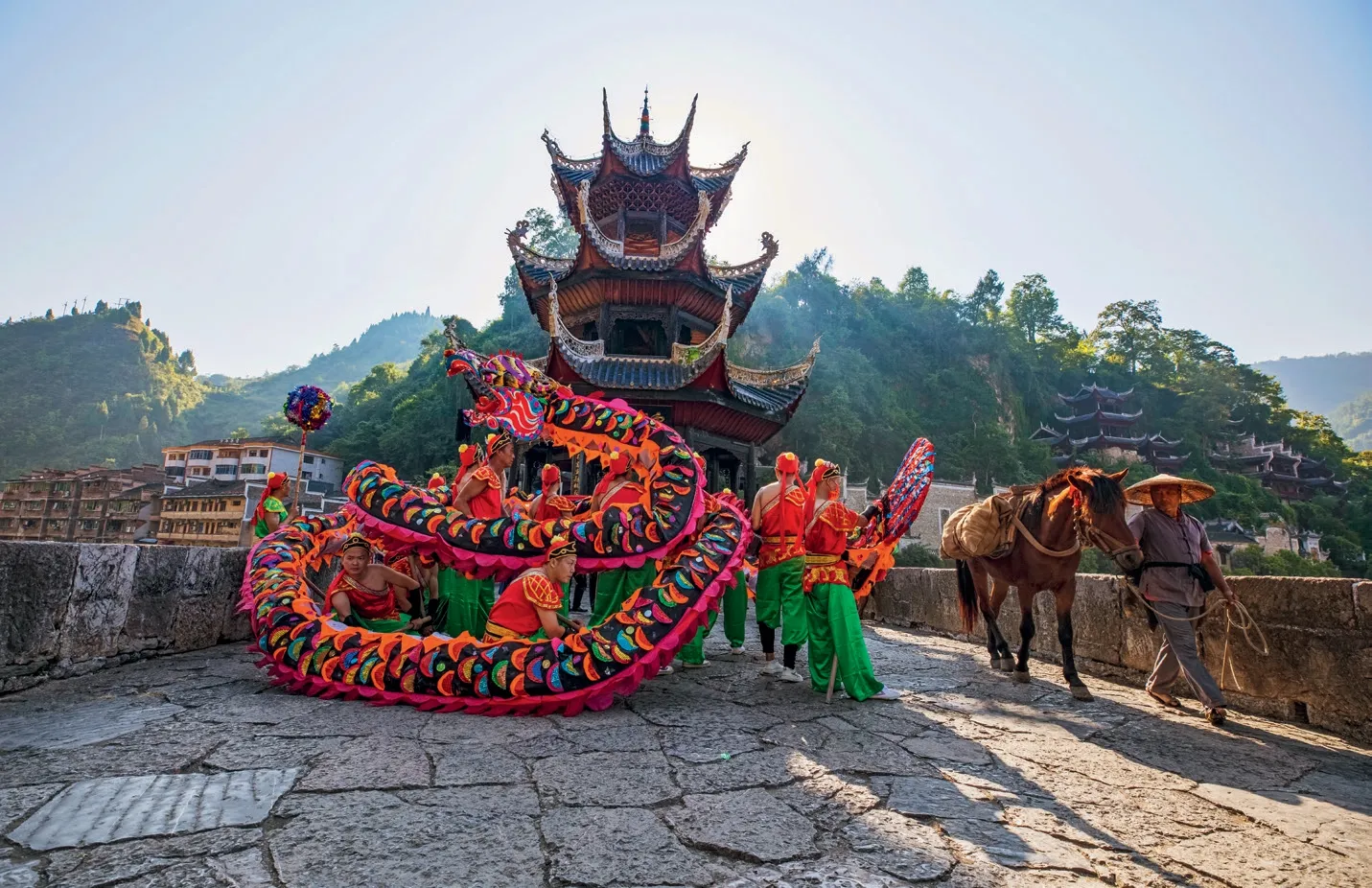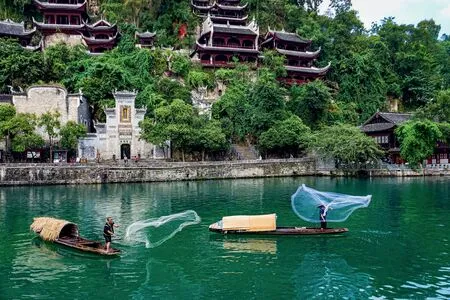Ancient Zhenyuan,Gateway to East Guizhou
By staff reporter MENG JIAXIN
This ancient city has a history going back over 2,000 years.It has witnessed the fusion of multiple ethnic cultures including the Miao,Dong,and Han,and hosts a number of cultural heritage sites.

Some tourists enjoying a stroll down the streets of the old city of Zhenyuan at night.
THE old town of Zhenyuan is located in Zhenyuan County,Qiandongnan Miao and Dong Autonomous Prefecture in southwest China’s Guizhou Province.Covering an area of just around three square kilometers,it sits on the banks of the Wuyang River and is surrounded by mountains.Zhenyuan has been a county for more than 2,281 years and was the prefectural capital during the Yuan (1271-1368) and Qing (1644-1911) dynasties.It is a multicultural region,with Miao,Dong,and other ethnic minorities making up nearly half of the population.
Its rich history and diverse mix of ethnic groups and minority cultures has resulted in an abundance of historical and cultural legacies.It boasts the ancient architectural complex of Qinglong Cave and more than 160 ancient dwellings and old alleys dating back to the Ming(1368-1644) and Qing dynasties.Today,Zhenyuan is a national 5A tourist attraction.

A group of people are performing a dragon dance in the old city of Zhenyuan.
River and Docks
The Wuyang River meanders through Zhenyuan,carving an "S"shape,with the old administrative district on the north bank and the defense section on the south bank.When looked at from a high vantage point,they look like the two parts of aTaijisymbol from Chinese philosophy.Both sections of the old city were built during the Ming Dynasty.Visitors can stroll along the old city walls and enjoy the charm of old buildings and historical sites along the way.
Connecting land and water transport,docks are a major feature of Zhenyuan,signifying the ancient town’s importance as a transport hub in the past.There are five docks in the defense section of the city,mainly for military use,and the administrative district has seven docks for trade and commercial activities.These docks are connected with streets,alleys,houses,barracks,and barricades,allowing Zhenyuan’s residents to access the Yangtze River through the Wuyang River.
Many travelers choose sightseeing cruises to experience the old water transportation network and the scenic and historical landscapes on the banks including the 12 docks,old waterways,waterway city gates,and old bridges.
Ancient Alleyway
During the Song (960-1279) and Yuan dynasties,Zhenyuan became a city of political,economic,cultural,and military significance in east Guizhou.The soldiers who were dispatched to Zhenyuan brought architectural styles and techniques from their hometowns with them.In light of the topography of the mountains,people built all types of buildings as well as the famous “crooked streets” and a complex maze-like network of alleys.
Zhenyuan’s narrow and long ancient alleys are laid out in a complex network.So far,there remain seven ancient alleys,all built on the Shiping Mountain overlooking the Wuyang River.These alleys traverse the mountainous terrain and all lead directly to the riverside roads by the docks,which made it convenient for the dock workers to unload goods and directly transport them to the alleys in the past.

Some fishermen catching fish in a traditional way on the Wuyang River.
The “crooked streets” are a unique feature of Zhenyuan’s residential area.The gates of houses in the alleys were never built parallel or perpendicular to the street,and the doors of central rooms never directly faced the street,but were intentionally slanted along the street.According to old residents,this tradition can be traced back tofeng shuimasters’ wisdom.The underlying logic of such a design was that it brought the residents fortune and security,as people passing by would not instantly discover how rich the owners were with one glance.

A resident is fetching water from a well in the old city of Zhenyuan.
Some of the old residential buildings in Zhenyuan are well preserved.Tourists can climb up stone steps on streets lined with old houses featuring brick walls,exquisitely-carved window frames,and black tiles.The setting transports people back to the times of the Ming and Qing dynasties over 600 years ago.
Passing through the residential area,visitors can walk up the ancient roads to explore the wall surrounding the administrative district.The wall was built during the Zhengde period (1506-1521) of the Ming Dynasty on the Shiping Mountain in the north of the city.It is known as the “Great Wall of the Miao People.” This remaining wall was two kilometers long,and made of stone.During the Ming Dynasty,the wall played a vital role in protecting Zhenyuan.
There is a 200-yearold sweet osmanthus tree in front of the Main Hall,and visitors can hang a red ribbon on the tree for good luck.
Qinglong Cave
The Qinglong Cave is one of the must-visit attractions in Zhenyuan.It is one of the most representative ancient cliff garden architectural complexes,and is considered one of China’s top three hanging temples.This scenic spot faces the Wuyang River and covers an area of more than 21,000 square meters.Traces of Buddhism,Confucianism,and Taoism can all be found in the Qinglong Cave.It has 36 buildings,making it one of the largest ancient architectural complexes in Guizhou Province,and also a national key cultural heritage site under state protection.
The Zhongyuan Zen Temple is a Buddhist shrine in the Qinglong Cave.The Main Hall (Mahavira Hall) on the first floor was built in 1530 during the Ming Dynasty,and now houses a jade Sakyamuni statue.There is a 200-year-old sweet osmanthus tree in front of the Main Hall,and visitors can hang a red ribbon on the tree for good luck.
Around 600 years ago,the legendary Taoist Zhang Sanfeng came to practice in the region.The Zhongyuan Cave,situated high on a cliff,is where he is said to have lived and is the largest cavern in the Qinglong Cave Scenic Area.The Yuhuang Pavilion is the place where Zhang Sanfeng practiced and is the highest point of the Qinglong Cave,overlooking the ancient city.
Ziyang Academy is a place for Confucian followers to study,equivalent to a renowned high school of ancient times.It consists of several ancient buildings.A statue of Confucius stands in the Shengren Hall.The two characters “Xie Qu” inscribed on the plaque of the Sanjiao Pavilion indicate the harmonious coexistence of Confucianism,Buddhism,and Taoism at the Qinglong Cave.The Kaoci Temple and the Laojun Temple are revered places for studying and examination.
The Wanshou Palace is the largest section of the Qinglong Cave.In the Ming and Qing dynasties,it was used by businessmen coming from Jiangxi Province to welcome guests and friends and discuss matters.The major part of this section is a theatrical stage,which is one of the best preserved in Guizhou.A work of wooden carving placed under the stage can be regarded as one of the wonders at the Qinglong Cave.It features more than 60 lifelike characters from a classic play titledGenerals of the Yang Family.
Dragon Boat Race
Every year around the time of the Dragon Boat Festival,the level of the Wuyang River that passes through the city rises significantly and forms a wide water surface,presenting a natural and high-quality track for Dragon Boat race.During the Spring and Autumn Period(770-476 BC) and Warring States Period (475-221 BC),Zhenyuan was under the jurisdiction of the state of Chu.Since ancient times,there has been a custom of dragon boat race to commemorate Qu Yuan,a distinguished patriotic poet of Chu.During the Ming Dynasty,Zhenyuan enjoyed the reputation of "the home of the dragon boat."In the mid-1990s,the Zhenyuan Dragon Boat Festival was officially launched,and in 2011,it was included in the national list of intangible cultural heritage items.
Dragon boat race in Zhenyuan is a sport for everyone.Every street has its own dragon boat team,and the dragon boats of participating streets or villages are of different colors and shapes.Some of the boats have giant customized wood carved dragon heads to show off the local traditional wood carving skills.
ln recent years,local authorities have stepped up efforts to protect the heritage sites in this ancient city.

A beautiful quaint old bridge connects two parts of the old city.
Dragon boat race is a water sport that requires teamwork,so each participating team usually starts practicing intensively a few months before the race.In dragon boat race,each boat has gong players and drummers onboard.The sound of gongs and drums is not only used to help regulate the speed of the dragon boat based on different water currents and the sections of the race,but also a way to boost the morale of team members.Every year during the Dragon Boat Festival,around 100 teams comprised of thousands of people in total,take part in dragon boat paddling.Additionally,tens of thousands of people from over a dozen towns put on a lively cultural parade on the bank.
In recent years,local authorities have stepped up efforts to protect the heritage sites in this ancient city,and many sites have been repaired or are under protection.In the old city of Zhenyuan,the demolition and rebuilding of ancient buildings are prohibited,with the intent of maintaining the original style and feel of the region to the maximum extent.At the same time,a new specialty food street was built,and a band of boutique homestays and hotels have emerged;rail and shuttle bus services are also available.These facilities are drawing more tourists to Zhenyuan,adding vitality to the ancient city.Tourists are able to sample the thousandyear-old traditional food of the Miao people and enjoy captivating night views of the Wuyang River.

